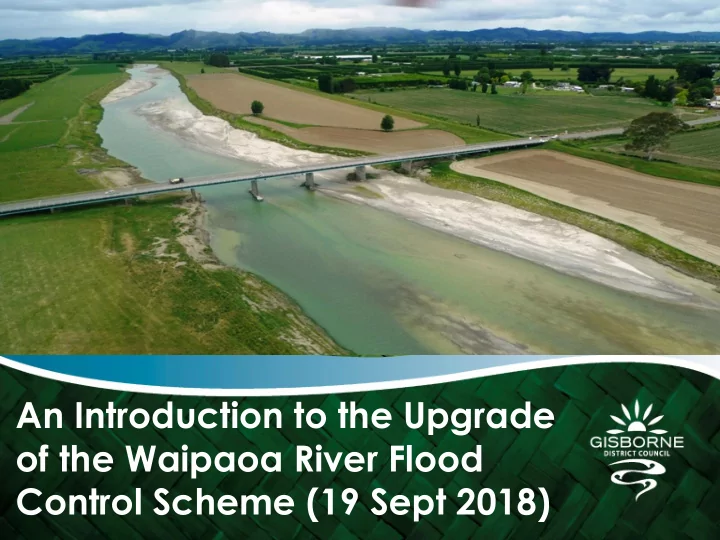

An Introduction to the Upgrade of the Waipaoa River Flood Control Scheme (19 Sept 2018)
Applicants Team Name Position Role Neil Daykin Operations Manager Project Business Owner Joss Ruifrok Senior Project Project Manager Engineer Stella Morgan Director of Sage Planning Consultant Planning Rachael Zame Associate with Legal Representative CooneyLeesMorgan Craig Goodier Principal Engineer River Modelling with Hawke’s Bay Technical Expert Regional Council Janic Slupski Senior Policy Advisor Landscape expert
Contents 1.0 Background 2.0 Project Overview 3.0 Investigations 4.0 Modelling & Design 4.1 Flood capacity 4.2 Design Flood Levels 4.3 Stopbank Design 4.4 Ormond Bypass 4.5 Mulloolys Bend 4.6 Upstream Properties 5.0 Wi Pere
1.0 Background The Waipaoa Flood Control Scheme (WFCS) began over 60 years ago. The WFCS was substantially completed by 1969 The WFCS consists of: 64km of stopbanks, Stopbank top widths of 2m, Stopbank heights range up to 6m, 638ha of productive land between the river & stopbanks (floodable berm), 76+ culverts, concrete walls, floodgates and related infrastructure. The WFCS protects $7 billion worth of land and property In the 2006 LTCCP, Gisborne District Council (GDC) continued its commitment to investigating upgrading the WFCS. In the 2009/19, 2015/25, & 2018/28 Long Term Plans, GDC committed to a WFCS upgrade resilience project.
1948 Flooding
June 2018 Flood, photo by Jordon Perry
2.0 Project Overview Project involves the upgrade of the existing the Waipaoa Flood Control Scheme (WFCS) Project also includes for the provision cycle trails along the stopbanks, Flows (discharges) are forecast to increase by 25% between now and 2090 due to a warming climate, Design will cater for a 1:100 yr flood event, accounting for climate change factors out to the year 2090, plus ‘freeboard’, ‘Freeboard’ is an additional height allowance to compensate for variables inherent in the design (0.6m applied), Will provide a ‘theoretical’ uniform LoS up to the design event Stopbank top width to be increased to 4m
Stopbank Comparison 10 9 8 7 Height (m) 6 5 4 3 2 1 0 0 1 2 3 4 5 6 7 8 9 10 11 12 13 14 15 16 17 18 19 20 21 22 23 24 25 26 Distance (m) OLD NEW • Top width = 1.8 m • Top width = 4 m • Height = 3 m (example) • Height = 4.3 m (example) • Freeboard = 0.3 m • Freeboard = 0.6 m
Stopbank Comparison 10 9 8 7 Height (m) 6 5 4 3 2 1 0 0 1 2 3 4 5 6 7 8 9 10 11 12 13 14 15 16 17 18 19 20 21 22 23 24 25 26 Distance (m) OLD NEW • Top width = 1.8 m • Top width = 4 m • Height = 3 m (example) • Height = 4.3 m (example) • Freeboard = 0.3 m • Freeboard = 0.6 m
3.0 Investigations 3.1 - Stopbank Foundations Ground Penetrating Radar (GPR) Scala Penetrometer Tests (SPT) Cone Penetrometer Tests (CPT) Results: Stability generally good, Lateral bank erosion a problem in some locations, Narrow berms in several places
3.2 - Stopbank Strength / Stability Results: Stability generally very good. However 2m top widths too narrow for safety and robustness. 4m now the industry norm. Instability under earthquake conditions - generally not significant (exceptions). Liquefaction under seismic conditions is a risk (settlement and lateral spreading) in the lower to mid reaches. Little that can be practicably done.
3.3 - River & Berm Width Results: Generally good berm width Some locations in critical areas have narrow berm widths Strengthening or berm widening may be necessary in places
4.0 Modelling & Design
4.1 - Flood Capacity Cyclone Bola event used as our calibration event (4500 cumecs) Design event is Bola plus 25% (Accounts for Climate Change effects (2.1 deg.C out to the year 2090) Bola +25% additional flow = 5625 cumecs = 2090 1% AEP discharge 5625 cumecs is our ‘Design Event’ Stopbank heights are modelled flood levels from a 5625 cumec event, plus 0.6m of freeboard.
4.2 - Design Flood Levels Updated the hydraulic model of the river 1D- 2D ‘coupled model’ being used for design Updated model reviewed by DHI modelling specialists Model assumes that all floodwaters are contained by the stopbanks (no leaks)
4.3 Stopbank Design
Stopbank Long Section based on cross sections every 100m’s for Stages 1 & 2 0.5m variation in stopbank level Higher stopbank, likely to account for Super Elevation on outside of bend 0.5m variation in stopbank level
4.4 Ormond Bypass
Proposed bypass
4.5 Mulloolys Bend
4.6 Upstream Properties
E C A B D
5.0 Wi Pere Trust
Wi Pere Trust Land
END OF PRESENTATION
Recommend
More recommend